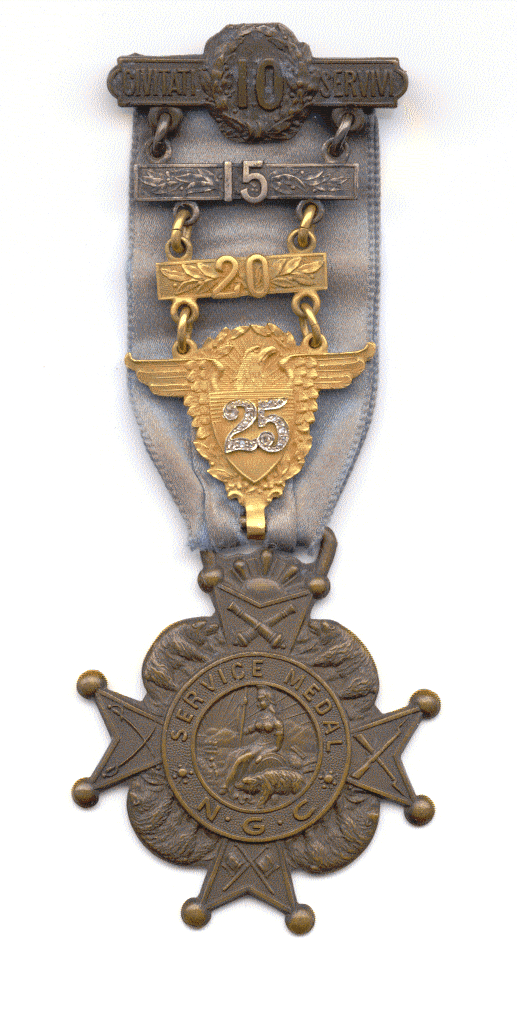
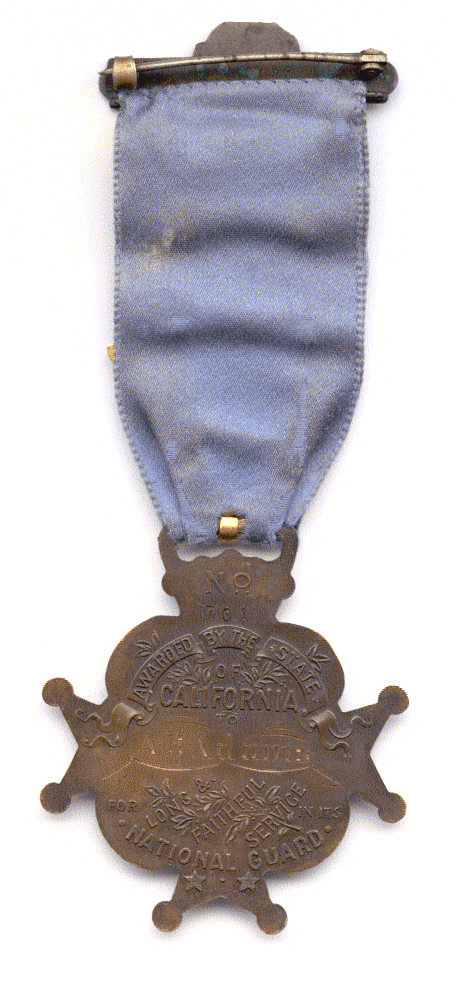


I am indebted to Captain Gregory Ogletree for his kind permission to use much of the data contained in this article, which came from his book: Awards and Decorations of U. S. State Military Forces, 1988. Patriot Press. I am also indebted to S. G. (Yas) Yasinitsky, OMSA#1 for his support, information, and friendship over the years.
The California Service Medal has a long and interesting history. For many California National Guardsmen it was the only medal they earned over their long careers in the Military service of the State. This medal is often ignored or over looked by collectors and military historians alike. I hope to add a little more information on this very interesting medal. I have used Captain Ogletree’s Type and variety class descriptions to be consistent with the material in his book were possible.
Criteria for Award: This medal is awarded upon personal application made by the recipient after the completion of 10 years of service in the California National Guard (Air or Army), Naval Militia, State Guard, State Military Reserve, State Militia, Defense and Security Corps, National Guard Reserve or for 10 years combined service in any of the above organizations. Service while on Active Duty with the Armed Forces is not creditable, although such service, if performed during time of war, was creditable until about 1986. Active Federal Service while in the California National Guard Federalized Status counts toward the award.
History: This award, the oldest of all medals awarded for longevity by any of the various states, was first authorized by the state legislature on March 20, 1889 (preceding the Massachusetts service medal by one year). This authority is recorded in Ch 279, Sec 13, Statues of California (codified as Sec 2101). The Act called for three medals (bronze, silver, and gold) to be awarded for 10, 15, and 20 years of service respectively. As far as can be determined the silver and gold medals were never struck.
In place of medals struck in different medals, bars were authorized on March 9, 1893. Chapter 92, Section 14, provided “... a bronze service medal, with a bronze bar attached thereto, for ten years active service (basic award); for fifteen years active service, a silver bar shall be attached; for twenty years active service a gold bar shall be attached to the same medal. There shall be no other or different medals for service.” This was codified in the Political Code of California as Sec 1945, and remained basically unchanged until provision for a twenty-five year award was made on March 9, 1911 with the passage of Ch 160, Sec 7. The Type 1, variety 1 style A ribbon medals were issued through at least # 756 (a numbered, but unnamed example in the Author’s collection).


The medal in Figure 1. (with 15, and 20-year bars) above was requested by application (letter) by the recipient on June 14th, 1912. It is believed the 25-year bar was awarded in early 1917 just prior to Federal Activation of the California Naval Militia for World War I. This medal, which is part of a group, was bought from the recipient’s grandson in April of 2000. The group consists of the following: World War I Victory Medal with Navy Escort bar (served on the Cruiser USS San Diego prior to her sinking); California Service Medal with 15, 20, and 25-year bars; California National Guard Marksmanship Badge Type 2 #6178 with bars: Marksman 1891, Rifleman 1901, Revolver Third Class 1904, and Revolver Third Class 1905; California National Guard Marksmanship Badge Type 2 #9239 with bars: Marksman 1913, Sharpshooter 1914, and Expert Riflemen 1915; 32nd Degree Masonic Medal (Jewel); Improved Order of Redmen Medal on green ribbon; 1901 Cal Convention International Order of Odd Fellows badge. Copies of his letter requesting award of the medal and supporting documentation are Figures 4 and 5.
The Type 1, variety 2, style B ribbon medal started being awarded sometime after World War I. It appears it was establish as the “New Type Service Medal” on 16 June 1933 (See the California Medal of Merit Section in Awards and Decorations of U. S. State Military Forces, by Gregory W. Ogletree, 1988, page 52). This variety was used no later than #910 and through at least #2634 (BG Hamilton collection). A number of War World Two groups contain these type 1 variety 2 service medals. Most appear to have had pre-WW2 National Guard service, and a number appear to have had some post WW2 National Guard service (with wartime service possibly counting toward the award). One WWII medal group containing the Type 1, variety 2, style B ribbon medal was awarded to a Captain in Battery F, 2nd Battalion 251st Coast Artillery with service from 1932 to the early 1950’s. His medal group consists of the following: American Campaign Medal; Asiatic-Pacific Campaign w/ 1 arrowhead, & 3 bronze campaign stars; World War II Victory Medal; Philippine Liberation Medal w/ 2 bronze stars; and the California Service Medal Type 1, variety 2, style B ribbon medal #2119 (Author’s collection).
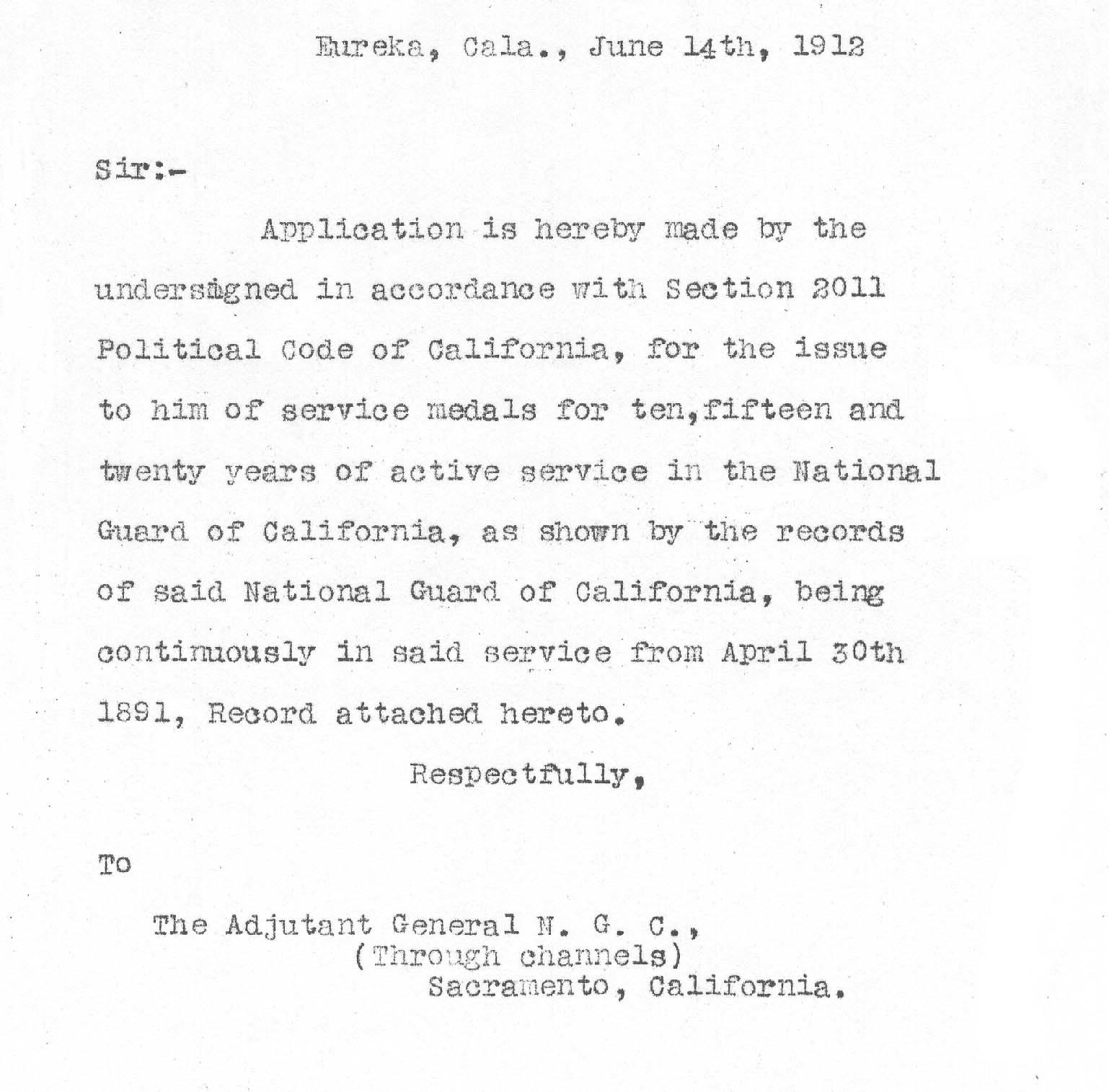

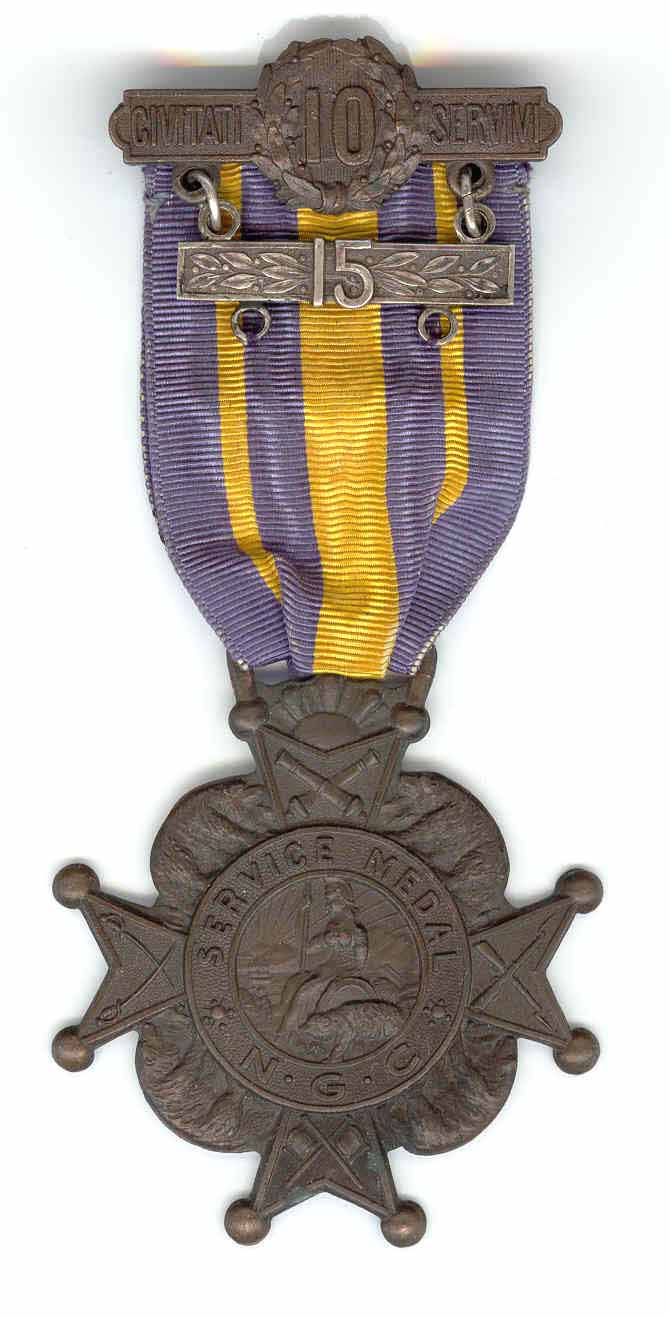
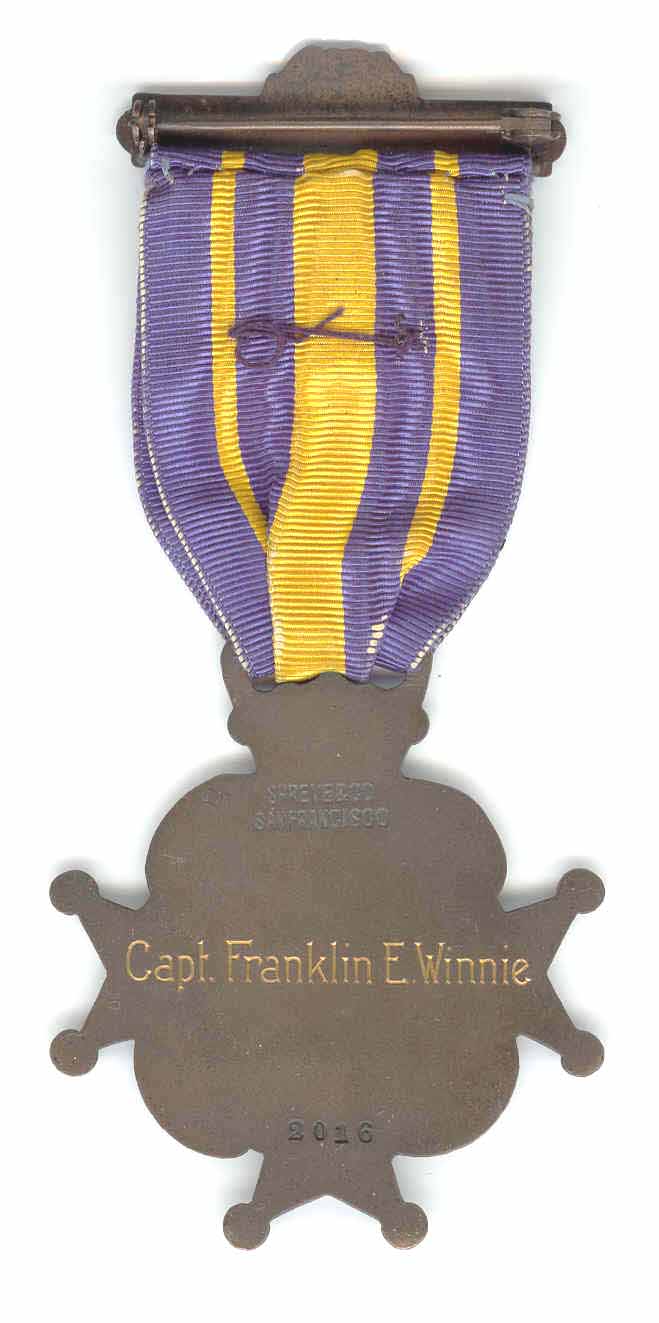
A second WWII group to a Captain in the 159th Infantry Regiment consists of the following: Combat Infantryman’s Badge, American Defense Medal, American Campaign Medal, European African Middle Eastern Campaign Medal w/ 3 stars, World War II Victory Medal, California Service Medal Type 1, Variety 2, Style B ribbon #2016 with 15 year bar (Came with ribbon with Bear Device), California 100% Drill Badge w/bars: 1938, 1939, Expert marksman badge w/bars; Rifle, Pistol-D (Dismounted).(Author’s Collection)

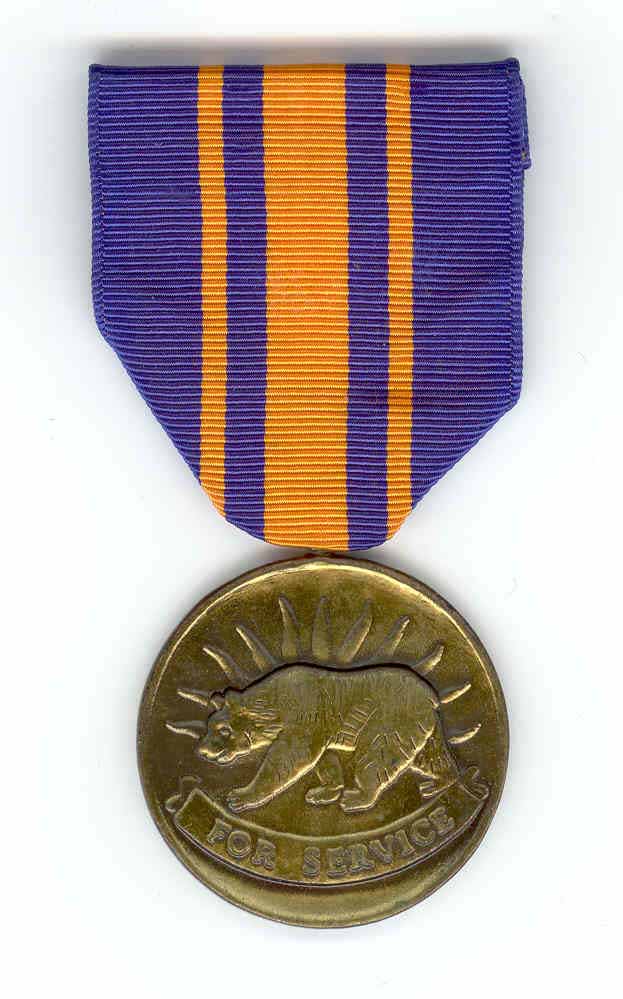
A new, cleanly styled Type 2 medal replaced these Type 1 medals, deemed by some as “grotesque,” in the early 1950’s. This is the circular medal with the bear on the front, and plain back. It is not known exactly when the first Type 2 medals were awarded, but the Biennial Report of the Adjutant General for 1954-56 provides quite a considerable list of recipients, most with dates of eligibility falling within the period of the report, but many more with dates in the early 1950’s, a few with dates in the 1940’s and one with a date of 1934. The Type 2 medal was not available for issue until 1953 or 1954, even though its design was finalized no later than mid-1950. The type 2 medal was issued in 2 varieties: variety 1 had a 3-ring suspension (one ring parallel to the medal, Figure 7.); variety 2 has the normal 1-ring suspension (ring or knob perpendicular to Medal Figure 8.).
In conclusion considering the history of this award (with the stipulation that the recipient had to make personal application for the medal), and had to have 10 years of service. It is obvious that the Type 1, variety 1 medals are extremely rare (with probably fewer than 900 ever being awarded). Also the Type 1, variety 2 medals are extremely scarce (probably with less than 2,000 being awarded).
Regimental Long Service Medals
2nd Artillery Regiment, Circa 1879

